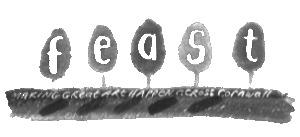The entries to the 2015 Charles Causley Poetry Competition were of a very high standard, and in addition to the first, second and third prizes, the judges selected five poets whose work showed particular skill or promise. In addition to a small financial reward, each of these five were offered the opportunity to engage in a virtual workshop process with our poet-in-residence, Isabel Galleymore.
Isabel has been critiquing and discussing the work of David Curtis, John Foggin, Jill Munro, Kirsten Irving and Andy Humphrey. We’ll be sharing their work throughout the week, but first, a word from Isabel about the process they have undertaken together during March.
‘It was a real delight to be asked, as part of my residency, to read and offer advice to those who have been Highly Commended in the Charles Causley Poetry Competition. In my workshops and readings since January, I’ve stressed the importance of having a variety of readers for new work – friends, fellow writers, family – but reading the work of those who are highly commended allowed the rare chance to comment broadly on two or three poems without any personal bias. After all, I hadn’t met any of the poets previously. Reading and commenting upon their work I wondered whether they lived in the places, or with the people, they described? Was this exciting risk-taking always part of their style, or a one-off experiment? Whilst I hoped this neutral perspective would afford an honest reading of the poems, providing feedback via email to poets I’d never previously met also brought its worries. As I self-consciously noted in my emails to the poets, it was nerve-racking to wonder whether my positivity and encouragement would translate over email.
Focusing upon the highly commended poems first, and then reading the comments made by the judges, I started to identify the strengths of each individual poet. I found David Curtis’s poems admirable in their intentions to explore their subjects from the inside out with a seeming self-consciousness to avoid sentimentality. Kirsten Irving’s work also took me by surprise: these poems exhibited a fearlessness in taking risks and this, personally-speaking, is what I’m always searching for when I read new work. In Jill Munroe’s work this risk-taking could be seen differently in the way certain poems played with line breakage and syntax, whereas others evoked more traditional forms. This playfulness expressed itself in even subtler forms in Andy Humphrey’s ‘Becoming Hedgehog’. Here, a sense of play was evident in the word ‘Kesh’ that describes ‘tyres on tarmac slicked/with leaves’. This made-up word drew my attention towards animal experience in a new way: not relying on sight, but on sound. In my response to these poems I tried to balance my feedback: identifying the strengths of the work, but also identifying where potential departures could be made. As part of this I tried wherever possible to suggest further reading that might be relevant. With Andy’s work I was reminded of Les Murray’s Translations from the Natural World. Reading John Foggin’s submissions to the competition that were threaded with landscapes, enquiries into our linguistic relationship with nature, and moments of concise imagery, I suggested Thomas A. Clark. Responding to my feedback, I was pleased that my comments had made a positive impact: for Jill Munro, who has just won the Fairacre Press Pamphlet Competition, my feedback helped to edit a poem considered for the publication. With Kirsten Irving my feedback brought up larger questions about the balance between the day job and the creative work. But to think that I’ve been the only one providing feedback would be wrong. Having read my pamphlet of poems, Dazzle Ship, David Curtis kindly noted a precision in my writing and a continuity of tense imagery, which has prompted me to see my practice in a new light. My readings and workshops during my residency have afforded similar dialogues. Reading to a group of students at Exeter College last week, Nathalie Young noted how my more descriptive poems are often led by form, rather than by other visual factors. As I hope my feedback has been useful to the development of these highly commended poets, these conversations have also allowed me to take a step back from my own writing, view it more objectively and consider my strengths.’













